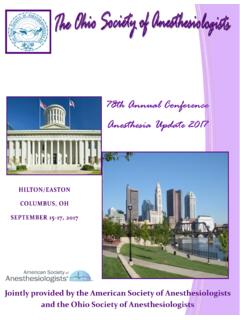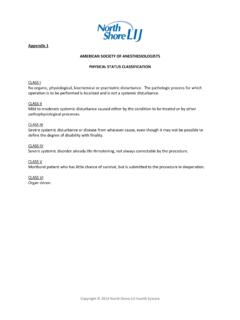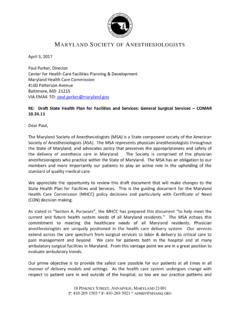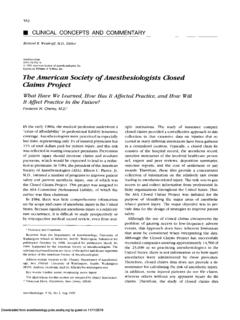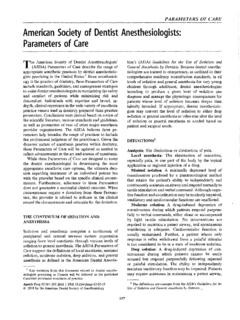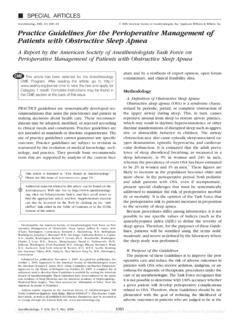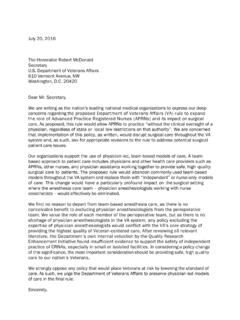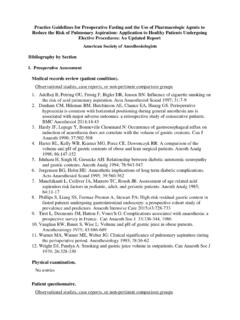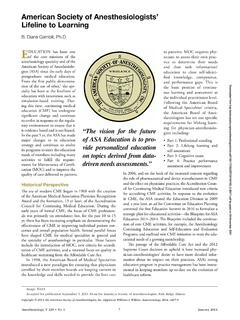Transcription of Sample Policy for Organ Donation after Cardiac Death
1 Sample Policy for Organ Donation after Cardiac Death This document has been developed by the ASA Committee on Transplant Anesthesia and the Committee on Critical Care Medicine in conjunction with the american society of Critical Care Anesthesiologists in response to anesthesiologists who have asked for advice regarding their role in Donation after Cardiac Death (DCD) Organ recovery. This Sample Policy has been reviewed by the ASA Committee on Ethics and the Committee on Critical Care Medicine but has not yet been approved as a practice parameter or Policy statement by the ASA House of Delegates.
2 This Sample Policy is intended to serve as an educational guide and possible template for DCD Organ recovery and transplantation policies that should be customized by any department or institution choosing to use it. Periodic review and revision of policies and procedures by clinicians, administration and legal representatives are warranted in keeping with the advances in technology and practice, in particular studies focused on identification and management of appropriate DCD donors.
3 This document is a Sample Policy and practice may vary based on sound clinical judgment of the responsible anesthesiologist and on the institution s policies and applicable laws and regulations. The concept of DCD has generated significant controversy, ethical concern, and emotional backlash in the public sector over the past decade. As such, most healthcare Policy groups and professional medical associations have studied the question of DCD with the overwhelming majority supporting a statement from the Institute of Medicine (1997) that determined Donation after Cardiac Death to be a medically effective and ethically acceptable way to reduce the gap between the supply and demand for donor organs.
4 Current practice was discussed by participants of the National Conference on DCD held in Philadelphia in 2005. Subsequent expansion of the practice of DCD has resulted from active support of the Organ Donation and Transplantation Breakthrough Collaborative and new Joint Commission on Accreditation of Healthcare Organizations (JCAHO) requirements that institutions develop and implement standardized DCD Policy . Introduction The practice of DCD involves the continuum of quality end-of-life care for patients and their families and withdrawal of treatments that are not beneficial.
5 Withdrawal of life support is not within the expertise of practice of all anesthesiologists. Optimally, patients presenting for Organ Donation after Cardiac Death should receive care from their own primary care physician and/or the attending of record who has established rapport with the patient, family, and/or agent. Agent means an individual authorized to make health-care decisions on the principal s behalf by a power of attorney for health care; or expressly authorized to make an anatomical gift on the principal s behalf by any other June 14, 2007 - 1record signed by the principal.
6 Anesthesiologists are the natural leaders and facilitators in the operating room and as such, should be knowledgeable and informed of the major practical and ethical issues surrounding DCD and Organ retrieval. Anesthesiologists should help to develop protocols within their own hospitals for provision of ethical terminal care for Organ donor patients and their families, with the assistance of guidelines developed by the Institute of Medicine and the United Network for Organ Sharing (UNOS).
7 Anesthesiologists should be respectful of the wishes of donor patients, their families, and their primary care physicians when they are in the operating room setting, but anesthesiologists should not be required to administer care to these patients. What is Donation after Cardiac Death (DCD)? The President s Commission on Death Determination supports two separate, but complementary sets of criteria. One is based on irreversible absence of circulation and respiration ( Donation after Cardiac Death , DCD), and the other is based on irreversible absence of whole brain function ( Donation after Brain Death , DBD).
8 Either is satisfactory for the determination of Death before Organ Donation . The Uniform Determination of Death Act The National Conference of Commissioners on Uniform State Laws in 1980 formulated the Uniform Determination of Death Act (UDDA). The UDDA states that: An individual is dead who has sustained either (1) irreversible cessation of circulatory and respiratory functions, or (2) irreversible cessation of all functions of the entire brain, including the brain stem A determination of Death must be made in accordance with accepted medical standards.
9 This definition was approved by the american Medical Association in 1980 and by the american Bar Association in 1981. DCD is an ethically acceptable practice and capable of increasing the number of deceased-donor organs available for successful transplantation. Most patients considered for DCD will have been in the intensive care unit (ICU) and are fully dependent on ventilatory and circulatory support. A decision to forgo/withdraw further life sustaining therapies will have been made in accordance with the patient s wishes and legal healthcare proxy before and independent of any discussions about DCD.
10 Most, but not all of these patients, will be neurologically devastated, but do not meet criteria for whole brain Death . DCD donor Death occurs when respiration and circulation have ceased and cardiopulmonary function will not resume spontaneously. Electrocardiographic (ECG) silence is not required for the determination of Death , because the criterion for determining Death is the absence of circulation. The period of observation necessary to determine that circulation will not recur spontaneously after removal of life sustaining therapies has been reviewed by many organizations.



